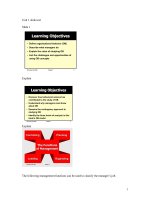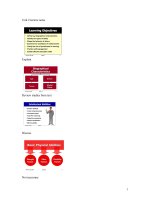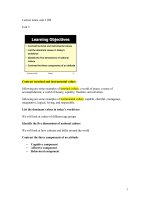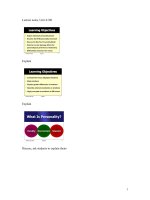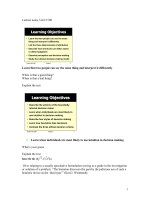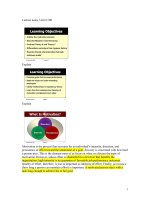Organizational behavior: Lecture 21 - Dr. Mukhtar Ahmed
Bạn đang xem bản rút gọn của tài liệu. Xem và tải ngay bản đầy đủ của tài liệu tại đây (709.7 KB, 65 trang )
Organizational
Behavior
(MGT-502)
Lecture-21
Summary
of
Lecture-20
The Communication
Process
Encoding
Channel
Message
Decoding
Message
Source
Receiver
Feedback
Nonverbal Communication
Body Motions
Body Language
Facial Expressions
Tone of Voice
Paralinguistics
Pacing and Pitch
Barriers to Effective
Communication
Directions of
Communications
Today’s Topics
Communication Principles
• Communication has purpose
• Communication is continuous
• Communication messages vary in
conscious encoding
Communication Principles
continued
• Communication is relational
• Communication is culturally bound
• Communication has ethical
implications
• Communication is learned
Functions of Communication
Control
Information
Motivation
Emotional
Expression
The Communication
Process
Intended
Message
(Encoded)
Perceived
Meaning
(Decoded)
Noise
Physical Distractions
Semantic Problem
Cultural Differences
Lack of Feedback
Status Effects
Basic Interpersonal
Communication Model
/
/
/
/
/
/
/
/
/
Communicator
/
/
/
/
/
/
/
/
/
Perceptual screens
Message
• Context
• Affect
/
/
/
/
/
/
/
/
/
Receiver
/
/
/
/
/
/
/
/
/
Perceptual screens
Influence message quality, accuracy, clarity
Include age, gender, values, beliefs, culture,
experiences, needs
Event
X
Interpersonal Communication
• Oral Communication
– Advantages: Speed and feedback.
– Disadvantage: Distortion of the message.
• Written Communication
– Advantages: Tangible and verifiable.
– Disadvantages: Time consuming and lacks feedback.
• Nonverbal Communication
– Advantages: Supports other communications and provides
observable expression of emotions and feelings.
– Disadvantage: Misperception of body language or
gestures can influence receiver’s interpretation of
message.
The Contribution of Communication
Activities to Real Managers’
Effectiveness
Routine
communication
44%
Networking
11%
26%
Human Resource
Management
Traditional
management
19%
Upward
Direction of
Communication
Downward
Lateral
Communication
Networks
Formal
Informal
Vertical
Multidirectional
Follows authority
Skips authority
Task-related
Social-related
Common Small-Group
Networks
Wheel
Chain
All-Channel
Small Group Network
Effectiveness
Networks
Criteria
Speed
Chain
Moderate
Wheel
Fast
All-Channel
Fast
Accuracy
High
High
Moderate
Emergence of
Leader
Moderate
High
None
Member
Satisfaction
Moderate
Low
High
The Grapevine
Control
Reliability
SelfInterests
Barriers to Communication
• Perceptual and Attributional Biases
• Interpersonal Relationships
• Top Management’s Role
• Gender Differences in Communication
• Physical Distance
• Organizational Structure
What Will Your Audience
More
Remember?
How Much is
Remembered
As time passes, your
audience remembers less.
Less
More
How Much Time Passes
Electronic
Communications
• Work space
• Work life and personal life
• Organizational boundaries
• Time constraints
• Geographical constraints
• Interpersonal contact
Technology and
Communication
Electronic Mail
The Internet
Computer-Mediated
Communication
•
•
•
•
•
Informational databases
Electronic mail systems
Voice mail systems
Fax machine systems
Cellular phone systems
How Does CMC Affect
Communication?
• Fast, immediate access to information
• Immediate access to people in power
• Instant information exchange across
distance
• Makes schedules & office hours
irrelevant
• May equalize group power
• May equalize group participation


